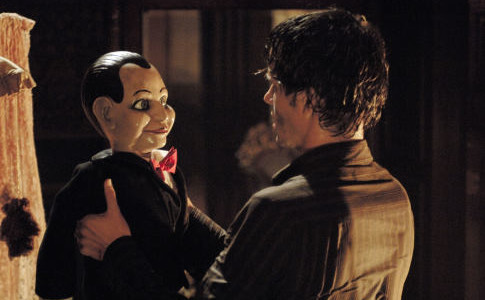In 2022, James Wan and Leigh Whannell are horror institutions, a duo to whom we’ve long since conferred “Masters of Horror” status. But just fifteen years ago, it was fair to wonder if they would be a flash in the pan as they plotted their sophomore effort to follow-up SAW, a movie that needs little introduction. While the duo did oversee the production of that film’s first two sequels, their second proper collaboration, DEAD SILENCE, took nearly three years to hatch, which makes sense considering the enormous weight that must have been on their shoulders to follow such a momentous first act. SAW wasn’t just a franchise-spawning hit—it signaled a sea change in the genre and helped to usher in an era of twisted, ultra-violent American horror.

Whatever came next was destined to be in its shadow, so it’s no surprise that DEAD SILENCE didn’t reach those lofty heights; more surprising, perhaps, was just how thoroughly it fizzled out upon arrival. Dismissed by audiences and critics alike, it was a film that became synonymous with disappointment and left its filmmakers licking their wounds before they’d come to define the landscape of the next decade with the likes of INSIDIOUS and THE CONJURING. In retrospect, though, DEAD SILENCE should have let us know that Wan and Whannell weren’t going to be content to rest on their laurels, as it was the first of many times this pair zigged instead of zagged. When faced with the impossible task of following SAW, they didn’t just resist retracing their steps—they practically sprinted in the opposite direction, an approach that’s bound to alienate audiences.
For a brief moment, DEAD SILENCE does what might be expected of it. Set in the tight confines of an apartment, Jamie Ashen and his wife Lisa (Ryan Kwanten & Laura Regan) receive a doll carrying a cryptic message referencing Mary Shaw. While Jamie leaves to pick up some food, the doll attacks Lisa, causing her to miscarry; by the time he returns home, she’s been slashed to death, her tongue gruesomely cut out. DEAD SILENCE might be quicker to indulge violence than its predecessor, but it feels of a piece with SAW, right down to the mysterious doll being named BIlly.
But that’s just about all the two have in common. With $20 million of Universal’s money at their disposal (literally 20 times what they had on SAW), Wan and Whannell eschew the intimate, lo-fi griminess of their debut’s chamber drama approach, opting instead to paint on a sprawling, gothic canvas once Jamie returns to his hometown of Raven’s Fair. True to its name, Raven’s Fair is something of a ghost town: heralded by a dilapidated sign and shrouded in fog, it’s a place that feels slightly out of time with its retro roadside motel and an old, decrepit theater hoarding its share of secrets. As Jamie eventually learns, it’s haunted by the story of Mary Shaw (Judith Roberts), a ventriloquist who was blamed for killing a young heckler and lynched, only to supposedly return from the grave as a doll and take revenge on the town. Only those who don’t scream at her ghostly presence are spared; those who do have their tongues ripped out, a ghoulish echo of the woman’s own demise.
Anyone expecting a SAW redux in 2007 was greeted by something altogether different, as DEAD SILENCE is a candy-colored campfire story brought to vivid, spooky life. It has a different sort of energy than its predecessor since it thrives on gothic atmospherics and is more deliberately plotted, giving Wan ample opportunity to indulge pure aesthetics. If nothing else, DEAD SILENCE is visually breathtaking, full of the type of opulence you’d expect from an indie filmmaker playing in a big studio sandbox for the first time. Whether he’s capturing dingy motel interiors or the decaying theater (literally named the Grand Guignol), Wan brings a certain grandeur to it all that foreshadows the wild, unhinged imagination he’d unleash in later works. Other hallmarks of Wan’s burgeoning style—frenetic editing, inventive camerawork, sharply orchestrated jolts—give more personality to a macabre ghost story that has surprises lurking around every turn: an assortment of ghoulish puppets, sick gore outbursts, among other eccentric flourishes. For whatever reason Donnie Wahlberg’s detective Lipton compulsively shaves with an electric razor, a tic that’s never explained but is ultimately exploited for a humorous gag during the climax, when it becomes abundantly clear that DEAD SILENCE is some silly shit. While there’s some playfulness to SAW’s climatic reveal, it’s obvious that Wan and Whannell are just going for broke here, like a couple of kids who snuck into the backdoor of a candy store and proceeded to ransack it. Even the climactic twist—one of the few moments that does feel like a deliberate echo of SAW—is so outlandish that you can’t help but howl at the absurdity of it all.
Clearly, it’s not something most audiences wanted back in 2007, including yours truly. Yes, I’d love to claim I’ve been championing DEAD SILENCE since its release, but I was one of the many who felt a little underwhelmed, if not downright thrown for a loop. Just what, exactly, was this weird, silly ghost story, and why wasn’t it more like SAW? It didn’t help that this era of hyperviolence dovetailed with my gorehound phase, that obligatory time in a horror’s fan life where the genre is all about pushing boundaries and uncovering fucked up shit. Unlike the grim, gritty SAW, the fantastical DEAD SILENCE didn’t quite fill that quotient—despite being fairly twisted in its own right. I couldn’t see the forest for the trees and dismissed the film’s otherworldly atmosphere as being too silly to take seriously, completely missing that maybe this was the point. Perhaps having seen what they’d unleashed with SAW, they made a conscious choice to make a garish, gothic throwback, something I should have seen coming from the moment it opened with a vintage Universal Studios logo. DEAD SILENCE should have provided a valuable lesson in approaching a film on its own terms rather than imposing my own expectations on them. Fifteen years, I’m certainly a little older, and I’m at least wise enough to recognize how delightful it was that this filmmaking duo refused to be boxed in by those expectations.
For its part, Universal didn’t do much to help matters by also imposing its own expectations, offering absurd notes and trying to force expository rules on a movie about killer puppets before unceremoniously dumping it into theaters with little fanfare. Whannell once chronicled the dispiriting experience on his now defunct blog, where he discussed the lessons learned from forcing a new idea to strike while the SAW iron was hot and working with studios, two things he obviously figured out how to navigate. Hollywood itself also seems to have learned to trust this duo, whether they’re paired up or flying solo, meaning the DEAD SILENCE saga has something of a happy ending. Look no further than the warm reception to Wan’s MALIGNANT six months ago as proof that we’ve come around to appreciating it when a filmmaker just wants to go buck wild. Then again, fifteen years and scores of hit movies will foster that kind of goodwill. Maybe it is just a retroactive case of The Emperor’s New Clothes, but I think it’s fair to say that DEAD SILENCE crawled, stumbled, and eventually lurched so MALIGNANT could run.
Tags: Amber Valletta, Anniversaries, Bob Gunton, Charlie Clouser, Donnie Wahlberg, Fred Tatasciore, Ghosts, Horror, James Wan, John R. Leonetti, Judith Roberts, Keir Gilchrist, Laura Regan, Leigh Whannell, Michael Fairman, Michael N. Knue, ryan kwanten, Twisted Pictures, Universal Pictures



No Comments